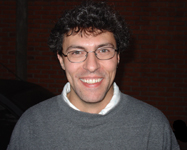Dr. Miguel Alcubierre
The New Scientist article Science: Surfing to the stars on warped space said
“The creators of Star Trek apparently knew a thing or two. According to one researcher in Britain, faster-than-light travel using the kind of ‘warp drive’ used on the USS Enterprise could be achieved without changing the laws of physics.‘I was watching Star Trek and I thought there must be a way to do this right’, says Miguel Alcubierre of the University of Wales in Cardiff. His method relies on modifying space-time: the three familiar spatial directions, with time as the fourth dimension. Previously, researchers have imagined travelling faster than light by travelling through a ‘wormhole’, a shortcut through space-time that connects widely separated regions of the Universe. Alcubierre’s method is neater, however; it involves making the space-time near a spaceship expand and contract.”
Dr. Miguel Alcubierre is a Mexican theoretical physicist. Born in Mexico City, he moved to Wales in 1990 to attend graduate school at the University of Wales, Cardiff, UK. He received his Ph.D. for research in numerical general relativity in 1994.
After leaving Wales in 1996, he worked for a time at the Max Planck Institute for Gravitational Physics in Potsdam, Germany, where he developed new numerical techniques to describe the physics of black holes. Since 2002 he has worked at the Nuclear Sciences Institute of the National Autonomous University of Mexico (UNAM), where he conducts research in numerical relativity, the effort to employ computers to formulate and solve the physical equations first proposed by Albert Einstein.
Miguel is best known for his Alcubierre drive, a theoretical means of traveling faster than light that does not violate the physical principle that nothing can locally travel faster than light. He authored The Warp Drive: Hyper-Fast Travel Within General Relativity. Watch or listen to his presentation on Simulation of Binary Back Holes at KITP Conference: Gravitational Interaction of Compact Objects. Listen to his Potsdam-3+1 Group Report which discussed the 3+1 decomposition of the Einstein field equations in relation to Colliding Black Holes: Mathematical Issues in Numerical Relativity. Read the Discovery Channel article Warp Drive. He appeared on the Discovery Channel special How William Shatner Changed the World.
He coauthored Symmetry without Symmetry: Numerical Simulation of Axisymmetric Systems using Cartesian Grids in International Journal of Modern Physics D, Test-beds and Applications for Apparent Horizon Finders in Numerical Relativity in Classical and Quantum Gravity, The 3D Grazing Collision of Two Black Holes in Physical Review Letters, and Gravitational Collapse of Gravitational Waves in 3D Numerical Relativity and A Conformal Hyperbolic Formulation of the Einstein Equations in Physical Review D.
Miguel’s solitary wave solutions of the Einstein field equations offer the unexpected possibility that general relativity may prove consistent with the experimentally verified non-locality of quantum mechanics. This assuages the fear that quantum non-locality would ultimately require abandoning the mathematical structure of relativity.
